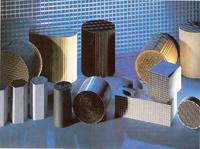Cleaning catalysts

They use catalytic oxidation, that is, using the oxygen available in the atmosphere and with the help of a catalyst, they burn harmful compounds.
In this process catalysts have many advantages. On the one hand, they reduce the energy needed for the combustion of harmful compounds, and on the other hand, for each polluting gas there are the corresponding specific catalysts. However, for this process to be effective, catalysts must have certain characteristics.
Where and how?
The catalysts consist of two main components: the support and the active phase. The support is usually a porous solid to get as much surface as possible, while the active phase is a compound that initiates the reaction. This active phase is normally a metal; platinum, palladium or zeolite, in the case of Leioa researchers.
In the combustion process the pollutant gas enters through the catalyst pores, where it reacts with the active phase. The reaction generates water, carbon dioxide and a halogenated compound, which is neutralized by a caustic soda shower. Only water and carbon dioxide are eliminated to the atmosphere.
In this case, researchers have investigated with zeolite catalysts, and the results indicate that the channels present in the zeolite structures have much to say in these reactions.
Zeolites can have parallel or crossed channels and it seems that zeolites with crossed channels are better catalysts for this type of reaction, since if there is any obstacle in parallel channels, the gases cannot advance, but yes in crossed channels.
Reaction kinetics
In addition to channel types, other parameters influence catalysis. The input gas flow, the number of catalysts used and the temperature of the combustion process are very important. Also the evolution or kinetics of reaction.
Temperature is one of the main indicators of reaction, as combustion of gases at the lowest possible temperature reduces energy use in the process.
Researchers are now looking to measure the durability of several catalysts. They want to know when to replace the catalyst or renew it with new active phases so that the combustion process continues to work properly.





